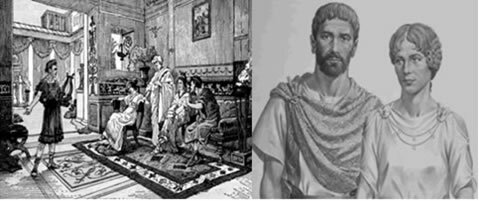The family in ancient Rome was patriarchal, that is, all authority was delegated to the man, to the father. The Roman family was an amalgamation of everything that was under the power of the pater families. The patriarch was the first of the household, so he performed all the religious, economic and moral functions that were necessary, the material goods belonged only to him. The Roman family representation was symbolized by the father and all power attributed to him ended only with his death. As the man was the master of the home, the Roman woman did not have the role of mistress of the home, as she was considered an integral part of the man. The married woman followed all the rules of good conduct and had some freedom to socialize.
Civil unions did not have the characteristic of the sacred arising from the birth of Christianity, but took place respecting some aspects of the Roman tradition. There were several types of marriage: the confarreatio, ceremony performed with a wheat bread,
There were weddings with very modern characteristics for the period: the sine manu and the usus. The first, sine man, it was the marriage that took place without the subordination of the woman to the husband's family, in this model of marriage the woman was allowed to enjoy her goods without any form of domination. The second, usus, it meant that the woman had been living with her husband for a year, but if the woman spent three consecutive nights away from home, that is, away from her husband, the marriage would be over. This was very common in the Republic. Despite all the modalities, marriage for the Romans was one of the most valued institutions.

Artistic presentation for the residents of a typical Roman residence - Couple of the Roman elite
Do not stop now... There's more after the advertising ;)
the historians Roger Chartier and Fhilippe Aries, in his work History of Private Life: from the Roman Empire to the Year Thousand, address that at the end of the Republic, divorce was customary, they they cite as an example Caesar, who repudiated his wife with the simple argument that Caesar's wife should not be suspected by anyone. Another example, that of the woman who contracted a single marriage, was considered by Roman society to be a woman of honor.
In the Roman family, the birth of a child did not guarantee that he would be received into the family. Many were left to fend for themselves or traded to pay off debts or even handed over as slaves. The number of children was usually three. There were laws that ensured the right to mothers of three children, as they fulfilled their duty to perpetuate of the lineage, although some documents confirm the existence of families containing a large number of sons.
When the child was not rejected, tradition dictated that a name be given on the eighth day, if she was a girl; or in the ninth, if it was a boy. The boys were given three names the praenomen (personal name that distinguished an individual from other members of the same family such as Marcus, Quintus, Publius), the name of the genes (group of people who shared the same family name as Julius, Cornelius) and the nickname (nickname that distinguished individuals within the same gens as Cicero, Scipio, Graco). The girls were designated only with the gentile name of their father, such as Livio (Lívia), Cornelio (Cornelia), Otávio (Otávia), Julio (Júlia).
The education and upbringing of children was the responsibility of a nurse and a slave who also exercised the role of pedagogue, who played a decisive role in the development of the youngster. As there was no public school, only the boys, if they belonged to a wealthy family, followed their studies, going through all the stages, up to graduation. A literature professor inspected them and so they studied classical authors, mythology, the humanities, rhetoric and oratory.
With this information we note the existence of the Roman legacy in our contemporary world. We perceive the changes, but we do not observe the permanences, even if these are in a different format, context and time, bearing a frightening resemblance to the past.
By Lilian Aguiar
Graduated in History
Brazil School Team

